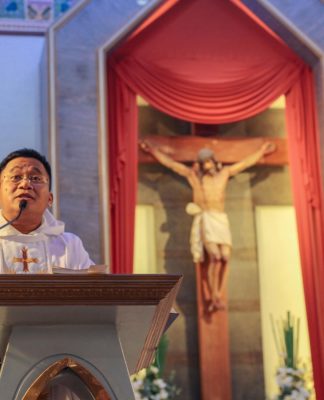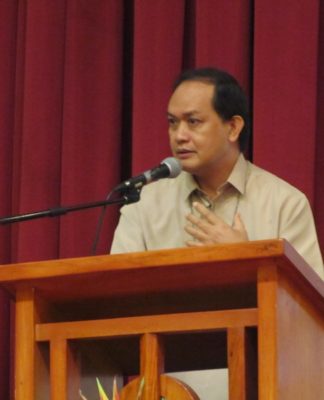PRESIDENT Macapagal-Arroyo led the inauguration of the Benavides Cancer Institute (BCI), the first one-stop cancer therapy center in the country, at the UST Hospital (USTH) last Aug. 21.
Named after UST’s founder, Fr. Miguel de Benavides O.P., the institute cost around P350 million to build and houses the most technologically advanced equipment for the diagnosis and treatment of cancer in the country.
Dominican Prior Provincial Fr. Edmund Nantes, Acting UST Rector Fr. Juan Ponce, and UST Central Seminary Rector Fr. Ernesto Arceo blessed the floors and rooms of the BCI. Prior to its inauguration, the BCI had already opened its doors on Aug. 7.
Ponce described the BCI as the “edifice that will not only lead in the treatment and prevention of cancer but an institute that will also confront a patient’s physiological needs.”
“This cancer institute will contribute to strengthening our national cancer control program and make the constraints less difficult in addressing the pain and the suffering of cancer patients,” Health Sec. Francisco Duque said.
“Through its renewed corporate governance and 100% equipment upgrading, the USTH has positioned itself ready to compete against advanced health-care institutions in the rest of the world,” Dr. Cenon Alfonso, president and chief executive officer of the USTH, said.
The BCI project was headed by an independent committee and group of doctors from the USTH specializing in different fields of cancer.
“The institute can be considered a one-stop hospital because the cancer patients will receive attention from the specialized group of doctors from diagnosis to treatment,” Dr. Rolando Cabatu, medical director of the USTH, told the Varsitarian.
“The BCI’s edge over other cancer centers is that the necessary staff and facilities are located in one structure,” Dr. Gina Panuncialman, institute director and head of the Chemotherapy unit, said. “The patients don’t have to travel from one place to the other in order to get their treatments done.”
The highlight of the institute is the P150-million Linear Accelerator (Linac), a machine that delivers faster and more accurate radiation beams on cancer areas. It is housed in a two-meter-thick walled room on the ground floor.
Other high-tech equipment in the BCI are the Dual Head Gamma Camera, Lithotripter, Radio Frequency Ablation, and Endoscopic Ultrasound (See related article on p.10).
Several specialized cancer facilities such as the Brachytherapy room, Mould room, an Ambulatory treatment unit, an adult and pedia Chemotherapy Ward, and multidisciplinary cancer clinics like the Breast, Head and Neck, Gastrointestinal, Thoracic, Gynecologic, Genitourinary, Adult Hematology, and Neurology clinics.
BCI officials said the institute will also undertake studies and researches on cancer.
“Since we now have treatment gadgets, our next acquisition will be on research. Cancer research is the most demanding of all the hospital researches but we aim to produce medical research papers that are distinctly ours,” Cabatu said. “We will also tie up with international institutions on cancer prevention and on the new modalities of cancer treatment which are necessary in educating those who will be doing any type of research on cancer from clinical to experimental in the hospital.”
The BCI is the first of four institutes that the USTH will be putting up as part of its five-year development plan. The other three are the Cardio-Vascular, Endocrine, and Metabolic and Organ Transplant Institutes.
The USTH is now preparing for the construction of three towers facing A.H. Lacson St. beside the BCI: a 17-story Medical Arts building that would house 250 doctors’ offices; a 22-story nursing tower that would offer international-standard nursing facilities; and a 7-story podium to accommodate the different functional areas of the hospital like the ICU complex, Diagnostic section, Emergency room, and Pharmacy. Adrian T. Elumba
Atop the BCI is the Angelo King audio-visual room named after its benefactor, Angelo King, a businessman turned philanthropist. It has a 201-seating capacity that would accommodate assemblies for general health-care agendas. Adrian T. Elumba

















